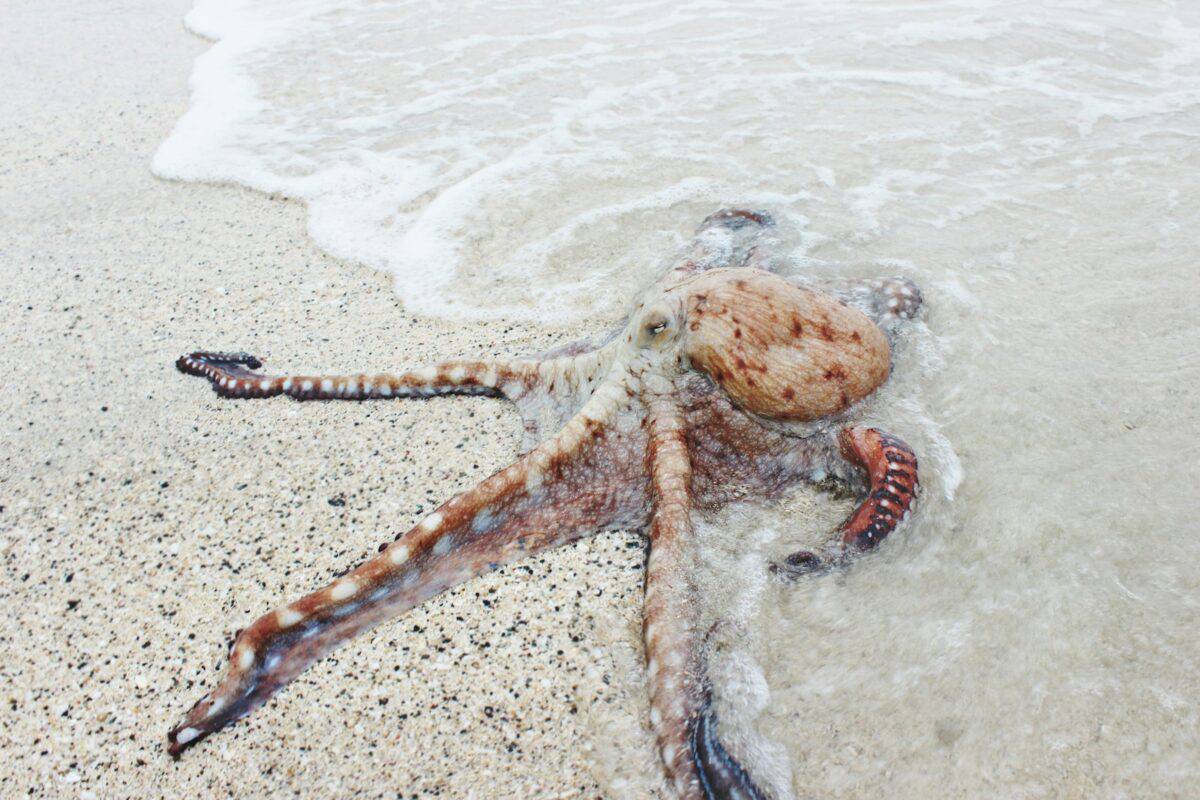Tool use was once considered a uniquely human trait, setting us apart from other animals. However, scientific research has increasingly revealed that numerous species across the animal kingdom demonstrate remarkable abilities to use and even create tools in their natural environments. This sophisticated cognitive ability involves selecting an object, modifying it if necessary, and using it to achieve a specific goal—whether that’s acquiring food, defending territory, or building shelter. From the forests of Africa to the coral reefs of the Pacific, animals have developed astonishing tool-using behaviors that challenge our understanding of animal intelligence. This article explores 14 fascinating examples of wild animals that have mastered the art of tool use, demonstrating that this cognitive skill extends far beyond human capabilities.
14. Chimpanzees The Master Tool Users

Chimpanzees are perhaps the most famous non-human tool users, with abilities first documented by Jane Goodall in 1960—a discovery that prompted Louis Leakey to remark, “Now we must redefine tool, redefine man, or accept chimpanzees as humans.” These great apes demonstrate an impressive repertoire of tool-using behaviors across different populations. They fashion fishing sticks by stripping leaves from branches to extract termites from mounds and ants from nests. In West Africa, chimps use stone and wooden hammers with anvils to crack nuts, a behavior that requires significant strength and precision. They even create spears by modifying branches to hunt smaller primates in tree hollows. Perhaps most remarkably, these tool-using traditions vary between communities, suggesting cultural transmission of knowledge—a trait once thought to be exclusively human.
13. Orangutans Engineers of the Forest

Orangutans, our distant cousins sharing 97% of their DNA with humans, are sophisticated tool users in their native forests of Borneo and Sumatra. These arboreal apes use sticks to extract seeds from fruits like the spiny Neesia, whose protective coating would otherwise make the nutritious seeds inaccessible. They fashion umbrellas from large leaves during tropical downpours and construct protective gloves from leaves when handling thorny food. Captive orangutans have demonstrated even more impressive abilities, using sticks to test water depth before crossing, fashioning tools to extract honey from artificial hives, and even attempting to use human tools they’ve observed. Wild orangutans have been documented using branches as back-scratchers and as tools to amplify their warning calls, suggesting that their tool use extends beyond merely foraging needs to comfort and communication.
12. Crows and Ravens Avian Geniuses

The Corvid family, particularly crows and ravens, exhibits some of the most sophisticated tool use among non-primates. New Caledonian crows are the standout performers, crafting hooked tools from twigs and serrated leaf edges to probe for insect larvae—a skill that requires complex manufacturing steps. These birds not only create tools but can solve multi-step problems, understand physical causality, and even improve their tools over time. In Japan, carrion crows have been observed placing walnuts on roads for cars to crack open, then waiting for traffic lights to change before safely retrieving their food. American crows have been documented fashioning tools from wire and other human-made materials, showing remarkable adaptability. These birds can also remember human faces for years and teach tool-using techniques to their offspring, demonstrating cultural transmission of knowledge—a cognitive ability once thought unique to humans and great apes.
11. Sea Otters Marine Tool Specialists

Sea otters are one of the few marine mammals that regularly use tools. These charismatic animals employ rocks as anvils to break open shellfish, a behavior essential to their survival. An otter will dive to the ocean floor to collect a clam, mussel, or abalone, then resurface with both the prey and a flat stone. While floating on its back, it places the stone on its chest and repeatedly smashes the shellfish against it until the shell breaks. Remarkably, sea otters maintain personal “tool kits,” storing their favorite rocks in loose skin pouches under their forelimbs for future use. Some otters even use rocks to dislodge abalones from rocks, showing problem-solving capability. Research indicates that mothers teach their pups these stone-using techniques through demonstration, suggesting cultural transmission of this vital survival skill through generations of sea otters.
10. Elephants Tool Masters with Trunks

Elephants possess extraordinary dexterity with their trunks, allowing them to manipulate objects with precision equivalent to a human hand. In the wild, African and Asian elephants fashion branches into fly swatters and scratching tools, showing remarkable awareness of their bodies’ needs. They’ve been observed digging wells with sticks in dry riverbeds to access underground water, then covering these wells with chewed bark to prevent evaporation—demonstrating not just tool use but planning for future needs. Elephants also modify branches to reach otherwise inaccessible food and use large sticks to scratch parts of their bodies they cannot reach with their trunks. In captivity, elephants have demonstrated even more elaborate problem-solving abilities, including stacking boxes to reach suspended food and using objects to weigh down electric fences. Their tool use highlights the sophisticated cognitive abilities of these highly intelligent social mammals.
9. Bottlenose Dolphins Sponge Hunters

In Shark Bay, Western Australia, a remarkable cultural tradition has emerged among bottlenose dolphins. A subset of the population, primarily females, has developed a unique hunting technique known as “sponging.” These dolphins carefully break marine sponges from the seafloor and wear them on their beaks (rostra) as protective tools while foraging. This behavior protects their sensitive snouts from sharp rocks and stinging creatures as they probe the seabed for fish that hide in the sandy bottom. What makes this behavior particularly fascinating is its cultural transmission—mothers teach their daughters this specialized hunting technique, creating a matrilineal tradition that has persisted for generations. DNA analysis suggests this behavior may have originated with a single innovative female decades ago. This represents one of the few documented cases of material culture and tool use in marine mammals, challenging our understanding of dolphin cognition and cultural learning.
8. Octopuses Eight-Armed Tool Users

Octopuses, despite being invertebrates with a nervous system vastly different from mammals, display remarkable tool-using capabilities. The veined octopus (Amphioctopus marginatus) collects discarded coconut shells, manipulates them into shelter, and carries them around for future use—clear evidence of planning ahead. This behavior has been described as the first known example of tool use in invertebrates. Other octopus species have been observed using rocks to wedge open clam shells and stacking stones to barricade their den entrances. In laboratory settings, octopuses solve complex puzzles, unscrew jars, and manipulate objects with exceptional dexterity. Their distributed nervous system—with two-thirds of their neurons located in their arms, allows for a unique form of embodied cognition, enabling each arm to partially “think” on its own while coordinating with the central brain. This sophisticated neural architecture gives octopuses problem-solving abilities that rival those of many vertebrates, despite their evolutionary distance from humans.
7. Egyptian Vultures Rock-Throwing Specialists

Egyptian vultures have developed a specialized tool-using technique to access a nutritious but otherwise inaccessible food source: ostrich eggs. These vultures use stones as hammers to crack open the thick-shelled eggs, which would otherwise be impervious to their beaks. The vulture selects an appropriately sized stone, grips it in its beak, and with a powerful swing of its neck, smashes it against the egg. This process may require multiple strikes before the shell finally cracks. Research has shown that this is not an innate behavior but rather a learned skill, with younger vultures observing and practicing the technique before mastering it. This represents one of the few documented cases of tool use among raptors. Some Egyptian vultures have even been observed throwing sticks at potential threats, suggesting their tool use may extend beyond foraging to defensive strategies. This sophisticated behavior highlights the cognitive flexibility and problem-solving abilities of these highly intelligent scavengers.
6. Gorillas Unexpected Tool Users

Though less studied for their tool use than chimpanzees, wild gorillas have demonstrated several notable examples of tool utilization. Researchers have documented western lowland gorillas using sticks to test water depth before crossing streams, much like humans might use a walking stick to gauge safe passage. Mountain gorillas have been observed using sticks to extract ants from nests and as walking aids on slippery terrain. Female gorillas sometimes use branches as tools during conflict resolution, throwing them to dissuade aggressive males. In captivity, gorillas have shown even more elaborate tool use, including using sticks to retrieve food outside their enclosures and manipulating complex puzzle feeders. These observations challenge earlier assumptions that gorillas rarely use tools in the wild and suggest that under certain ecological pressures or with proper opportunity, these great apes can develop sophisticated tool-using behaviors—further evidence of the cognitive continuity between humans and our closest relatives.
5. Capuchin Monkeys Stone Age Primates

Capuchin monkeys in Brazil have developed stone tool techniques remarkably similar to those used by early humans, earning them the nickname “Stone Age monkeys.” These primates use stone hammers and anvils to crack open nuts, seeds, and other hard-shelled foods—a behavior that requires significant precision and coordination. Archaeological evidence suggests this tradition has persisted for at least 3,000 years, with excavated sites revealing layers of stone tools used by generations of monkeys. Some capuchins even select stones based on their weight and material properties, showing an understanding of tool efficiency. In dry regions, they use sticks to dig for roots and probe for water. Female capuchins have been observed using stones as projectile weapons during mating competitions. Their tool use is particularly significant because these monkeys are not closely related to humans, suggesting that technological innovation can evolve independently in different primate lineages given sufficient ecological pressure and cognitive capacity.
4. Crocodiles Surprising Stick Users

In a surprising discovery that challenges conventional understanding of reptilian intelligence, researchers have documented multiple species of crocodilians using sticks as tools for hunting. During bird nesting seasons, alligators and mugger crocodiles balance sticks on their snouts and partially submerge themselves near heron and egret colonies. Birds collecting nesting material are attracted to the sticks, bringing them within striking range of the hidden predators. This behavior appears during specific nesting seasons and in particular locations where birds build stick nests, suggesting it’s a learned tactic rather than coincidental. Some scientists have also observed crocodilians using submerged logs as elevation aids for hunting, positioning themselves on these natural platforms to ambush prey more effectively. These observations represent the first documented cases of tool use in reptiles and suggest that the cognitive capabilities of these ancient animals may be more sophisticated than previously recognized, despite their evolutionarily distant relationship to mammals and birds.
3. Archerfish Aquatic Sharpshooters

Archerfish have evolved one of the most remarkable hunting tools in the animal kingdom—their ability to shoot down prey with precisely aimed jets of water. These fish can knock insects, spiders, and even small lizards off overhanging vegetation by firing water droplets from their specialized mouths with remarkable accuracy. The archerfish can adjust the force of its water jet based on the distance to the target, compensating for refraction at the water-air interface—a calculation requiring sophisticated physics. What makes this ability particularly impressive is that the fish must account for how light bends as it passes from air to water, effectively solving complex optical problems to hit their targets. Young archerfish learn this skill through observation and practice, gradually improving their accuracy. Some researchers classify this as tool use because the fish manipulates water as an external element to achieve a goal. This sophisticated hunting technique demonstrates how evolution can produce specialized adaptations that function effectively as biological tools.
2. Bonobos The Peaceful Tool Users

Often overshadowed by their chimpanzee cousins, bonobos display their own distinctive repertoire of tool-using behaviors in the wild. These great apes, sharing 98.7% of their DNA with humans, use sticks to dig for roots and probe for honey in tree cavities. Female bonobos have been observed fashioning rudimentary leaf umbrellas during rainstorms and using leafy branches to swat away biting flies. Unlike chimpanzees, who sometimes craft weapons for hunting, bonobo tool use centers primarily around foraging and comfort, reflecting their generally more peaceful social structure. They use leaves as napkins to clean themselves and as protective gloves when handling thorny foods. In captivity, bonobos have demonstrated even more impressive abilities, learning to crack nuts with stones without prior demonstration and using symbols on keyboards to communicate with researchers. Their tool use, while less varied than chimpanzees’, provides valuable insights into the evolution of technological behavior in the great ape lineage before the human-ape split approximately 6-7 million years ago.
1. Beavers Nature’s Engineers

While beavers are renowned for their dam-building abilities, their status as tool users remains subject to scientific debate. These semi-aquatic rodents manipulate natural materials with remarkable precision to construct elaborate dams and lodges—structures that can span hundreds of feet and last for decades. Beavers select specific types of branches and logs, transport them to construction sites, and arrange them in complex patterns, even incorporating stones and mud as reinforcement. They use their powerful front teeth to fell trees in predetermined directions and modify branches to fit specific structural needs. Some researchers argue this constitutes tool use, as beavers manipulate external objects for a specific purpose, while others consider it instinctive building behavior rather than true tool utilization. Regardless of classification, beavers demonstrate extraordinary problem-solving abilities, adjusting their construction techniques based on water flow and environmental conditions. Their engineering prowess creates wetland habitats benefiting countless other species, earning them recognition as keystone species and ecosystem engineers.
Conclusion: The Evolving Understanding of Animal Intelligence

The discovery of tool use across diverse animal species has fundamentally transformed our understanding of animal cognition and the evolution of intelligence. What was once considered an exclusively human trait now appears to have evolved independently multiple times throughout the animal kingdom, suggesting that the cognitive foundations for technology may be more widespread than previously thought. The varied examples of tool use—from chimpanzees crafting spears to archerfish projecting water jets—illustrate how different evolutionary pressures can produce sophisticated problem-solving abilities through entirely different neural architectures. These findings challenge anthropocentric views of intelligence and highlight the remarkable adaptability of animals across diverse ecological niches. As research techniques advance and we observe more species in their natural habitats, the list of known tool-using animals will likely continue to grow, further blurring the cognitive boundaries we once drew between humans and other animals and deepening our appreciation for the complex minds with which we share our planet.
- Jurassic World Dominion Dinosaurs - August 9, 2025
- 11 Signs a Rhino Is About to Charge - August 9, 2025
- 10 Common Chicken Behaviors and What They Mean - August 9, 2025

